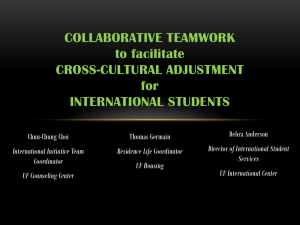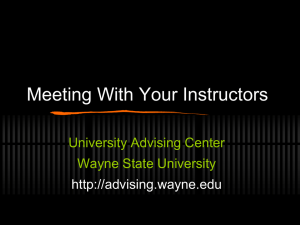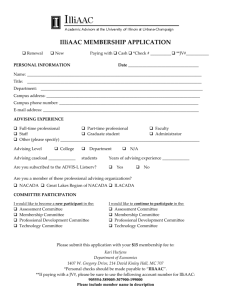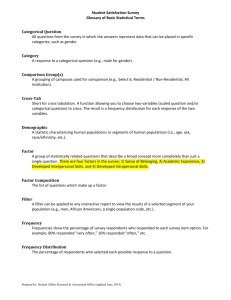Writing your Needs Assessment Report
advertisement
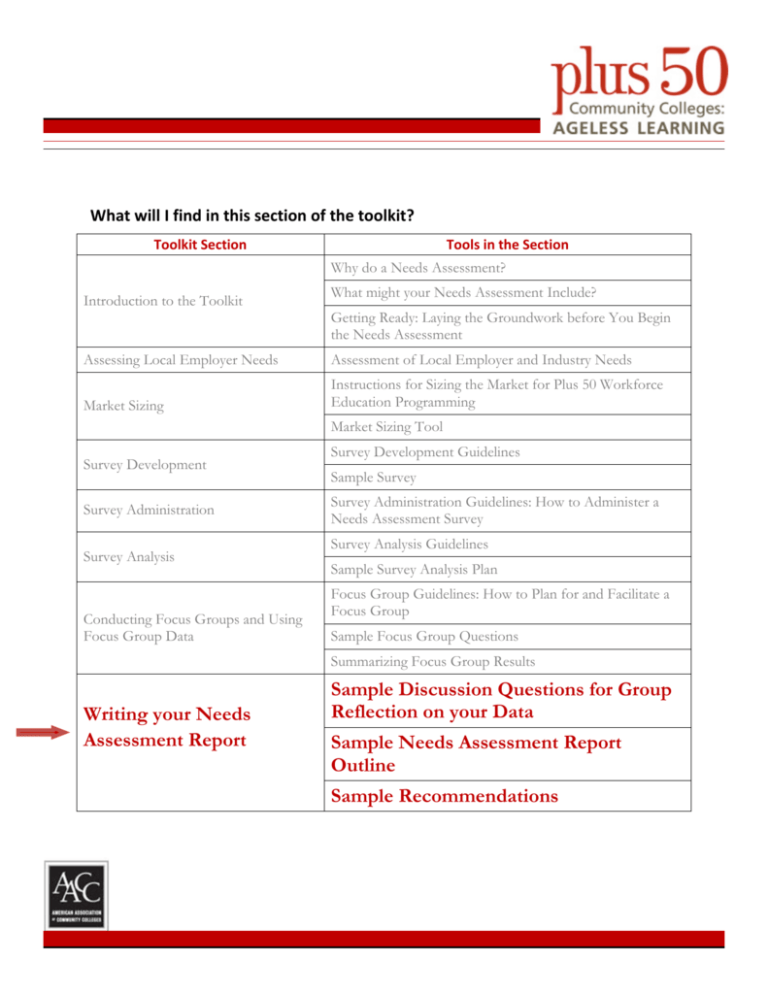
What will I find in this section of the toolkit? Toolkit Section Tools in the Section Why do a Needs Assessment? Introduction to the Toolkit What might your Needs Assessment Include? Getting Ready: Laying the Groundwork before You Begin the Needs Assessment Assessing Local Employer Needs Assessment of Local Employer and Industry Needs Market Sizing Instructions for Sizing the Market for Plus 50 Workforce Education Programming Market Sizing Tool Survey Development Survey Administration Survey Analysis Conducting Focus Groups and Using Focus Group Data Survey Development Guidelines Sample Survey Survey Administration Guidelines: How to Administer a Needs Assessment Survey Survey Analysis Guidelines Sample Survey Analysis Plan Focus Group Guidelines: How to Plan for and Facilitate a Focus Group Sample Focus Group Questions Summarizing Focus Group Results Writing your Needs Assessment Report Sample Discussion Questions for Group Reflection on your Data Sample Needs Assessment Report Outline Sample Recommendations Sample Discussion Questions for Group Reflections on Your Data This document is intended to provide you with some guidance for leading a conversation on the results and implications of your needs assessment work. When you have completed the data collection phase of your needs assessment, you will provide their thoughts on program design recommendations and next steps. If you have a formal Implementation Team and/or an Advisory Group, this is a perfect place to involve them. If you have been working on your needs assessment without formal assistance from such a team, you may find it helpful to pull together some people from different departments in your college at this stage. The questions in this tool are designed to help the group talk through the key findings of the data you have collected, determine which findings are most meaningful, and consider what recommendations emerge from these findings. Before you gather the group to have this discussion you should provide them with the written results from your needs assessment work, including survey and focus group analysis and the results of your market sizing research. After you have this conversation you should be in a good place to begin writing your formal report. Sample Discussion Questions 1. When you look at all the results from the needs assessment work, what catches your attention? 2. Which of the findings confirmed something you already knew? 3. What most surprised you? 4. Where do you have additional questions about the findings? 5. What do see as the most important results of the survey findings? Of the focus group findings? 6. What findings contradict one another? What findings confirm one another? 7. What implications do these findings raise in each of the following areas: a. The type of courses and programming we offer to plus 50 students? b. The instructional delivery of courses? c. The type of support and services we offer to plus 50 students? d. How we market our plus 50 program? e. What we charge for our plus 50 program? 8. What are the next steps for our college? Sample Discussion Questions for Group Reflection on Your Data | 2009 59 Sample Needs Assessment Report Outline I. II. Introduction and Background This section describes the purpose of the needs assessment and the specific questions the needs assessment investigate. Methods This section describes the methods used to collect the data and information presented in the “Key Findings” section of the report. a. Data Collection You should briefly describe each data collection method used. • Survey – include a description of who is in your survey sample, and how representative the sample is of your target market. • Focus Group – include a description of the group(s) that participated. • Market Sizing • Secondary Data Sources (e.g., other internet research) b. Strengths and Limitations Here you should describe the main strengths of your research, as well as any considerations that you want your audience to be aware of as they read and interpret the key findings. An example of a strength may be that there are many sources of information included in your Needs Assessment. An example of a limitation may be that due to resource constraints, you were unable to send the survey to members of the local plus 50 population beyond existing students. III. Key Findings This section summarizes the findings elicited from the data collected. Below are some you might include: a. Local Employer Needs and Growth Occupations This section summarizes the local employer needs, growth occupations, and necessary workforce skills gathered from publicly available data sources. b. Potential Plus 50 Learners in your College’s Area (Market Size and Description) This is where you include the summary of information calculated using the Market Sizing Tool. c. Competitor/Collaborator Information You may want to include a table listing other local organizations and agencies that provide workforce development or support services for the plus 50 population. This information is also sometimes referred to as an Asset Map. d. Plus 50 Learner Interests This section describes the following types of findings as collected by survey and/or focus group data: • Workforce Training Courses • Career Services and Supports IV. Recommendations for Program Planning This describes the implications from the data and suggests next steps for your college. These suggestions should include recommendations for programs and ways to increasing access to your college among the plus 50 population. V. Appendices You should include in the appendix the data collection instruments used, such as the survey and focus group questions. Sample Needs Assessment Report Outline | 2009 60 Sample Recommendations How to Use this Tool When you have collected all the data, completed the analysis, and written your findings, you are ready to consider everything together and develop recommendations. These recommendations will address a range of issues, such: as the fields in which to offer courses; whether to focus on individual courses for skills brush-up; what some popular schedules would be for accelerated courses; what types of services on which to concentrate when offering career supports; and whether to invest in assistive technology (e.g. for the hearing impaired). This tool provides sample recommendations based on the survey data presented in the Survey Analysis Guidelines portion of the tool kit. They are meant to give you an idea of how to proceed from data and interpretation to recommendations, and also how they might be presented. However, keep in mind that your own recommendations are likely to be very specific to your own college’s results, as well as to the context (what courses and services your college already has). To Develop Recommendations, Don’t Go it Alone! Sometimes an individual is tasked with writing the report, or specific sections. However, the task of writing recommendations is the perfect opportunity to involve your stakeholders – your implementation team, your advisory group, or other advisors. This is when everything comes together – as a group you can convene to consider the data that you have, what it all means, and brainstorm how it can best be applied to your college. You can explicitly task the group with coming up with a certain number of recommendations, and perhaps on particular topics. That way, when you sit down to write up the recommendations, the work has been largely done for you, and all you need to do is the fine-tuning. Please see the prior section of the tool kit, Sample Questions for Group Reflections on Your Data for suggestions on how to have a conversation about findings and recommendations. Using Results to Develop Recommendations Data on Concerns about Returning to Campus Barriers to Taking Courses n=212 There is a lot of information in this graph which can lead to recommendations about how to shape course offerings to attract plus 50 students to your campus, and also about how to provide specific services that will support a return to school. We will address just a few of them here. Concern about returning to a school environment after many years out of school 68% I need help choosing classes, and advising might be geared to young adults 63% The professors might be gearing their teaching style to young adults 62% Large proportions of the respondents had 0% 25% 50% 75% concerns about whether they could successfully Percentage of Respondents navigate courses at a college campus: 68% said Note, percentages do not total 100% because respondents could check all that apply. they were concerned about returning to a school environment after many years out of school; and 63% said they need help choosing classes, and fear that advising Sample Recommendations | 2009 61 might be geared toward younger adults. Both of these issues can be addressed through student services customized to the plus 50 student – for example, a special new student orientation, and tailored advising/counseling. In addition, 62% worry that professors might gear their teaching style to younger students. Sample Recommendations Regarding Concerns about Returning to Campus Ease the transition for plus 50 students through offering tailored new student orientation. Because 68% of plus 50 adults who responded to our survey worry about returning to school after many years, our college should address these concerns. To help students make the adjustment to our campus, we should offer a special orientation specifically for students over 50. The orientation should be led by someone who is a plus 50 student him/herself (or at least such a student should make a guest appearance at the orientation). At the orientation session, the leader can provide information on all of the resources available to students in this age group. We should not make this, however, an “orientation for seniors,” but instead a session that provides what this group needs to make good use of all campus resources. Another advantage of the plus 50 orientation is the fact that it will provide new students with an instant peer group. Support students’ ability to choose the right courses in a comfortable environment by offering tailored advising/counseling services. Sixty-three percent of respondents know they will need academic advising, but do not look forward to working with advisors who are used to counseling those who are at a much earlier stage in their life and career. The college should have an advisor who is trained to work with this age group, specifically around how to choose classes in light of goals for career development. Provide professional development for college instructors, and consider having some classes specifically geared to students 50 and over. Sixty-two percent of respondents believe professors might be gearing their teaching style to younger students, and see this as a barrier to attending courses at the college. Professors can, however, learn specific techniques of course delivery that not only make courses more “friendly” to people 50 and over, but also leverage the assets of this age group (typically they are more driven than the younger students and tend to come to class better prepared) for the benefit of the class as a whole. The college may also want to have a few classes that people know, ahead of time, will be customized to the learning styles of those who are 50 and over. This type of class would tend to attract people who are at least in their 40s, and – for some people – this may provide a more conducive learning environment. Data on Career Services Preferences Career services (n=187) Not very Extremely Important important important Career counselors have been trained specifically to understand the specific assets and challenges of a 50+ job seeker. Job fairs include only, or mostly, employers that are “plus 50 friendly.” The paper and electronic resources available focus on the job search and career issues specific to those who are 50+. 17% 28% 55% The data from the Needs Assessment Survey show that on each item, a 22% 35% 43% minority finds it “not very important.” Some items are especially important to the respondents – for 23% 36% 41% example, 83% believe that it is “important” or “extremely important” for career counselors to have been trained specifically to work with people in their age group. Sample recommendations regarding three of these items are below. Sample Recommendations | 2009 62 Sample Recommendations Regarding Career Services Preferences Hire, at least on a part-time basis to start, a career counselor who specializes in working with the job seeker who is 50 and over, or provide specialized training to current career counselors. Over half of the respondents (55%) said that it was “extremely important” to them to work with counselors who “have been trained specifically to understand the specific assets and challenges of a 50+ job seeker.” Only 17% said that it was “not very important,” which means that 83% said it was either “important” or “extremely important.” The respondents clearly have a strong preference for a counselor with specialized training. This is a good place for the college to make an investment, since the needs and job landscape is indeed different for job-seekers in this age group. Arrange for job fairs that include only, or mostly, employers who are “plus 50 friendly.” Staff providing career services to plus 50 students should make an effort to organize job fairs that have an element of customization to plus 50 job seekers. Plus 50 students often seek jobs in the same fields as those who are younger, so customization is not about what type of employer is at the job fair. The issue is that that ageism in the workplace is real, and plus 50 students do not want to waste their time developing relationships with employers that might well be looking for a younger hire. It is a better use of everyone’s time that job-seekers know from the beginning that the employers know the value of an experienced worker, and are enthusiastic about leveraging those assets. At a physical or virtual career center, make resources available that focus on the job search and career issues specific to those who are plus 50. Plus 50 job seekers, if they go to a “standard” career center or career Website, sometimes have to wade through a lot of material that does not address issues specific to those in their age group. At the same time, many of the career resources out there are perfectly suited to those 50 and older. However, it can become exhausting to review the universe of resources available, and demoralizing to see many resources geared to the younger person at a much earlier stage in their career. It saves a lot of time and energy if job seekers can go to a career center or a Website that they know contains information that is already “vetted” for relevance to their own needs and objectives. Sample Recommendations | 2009 63

